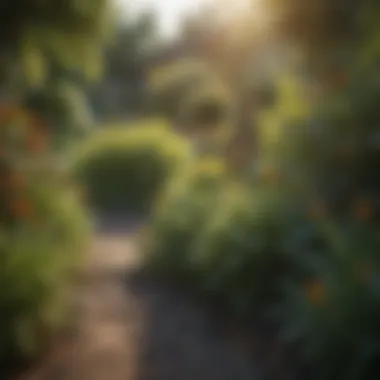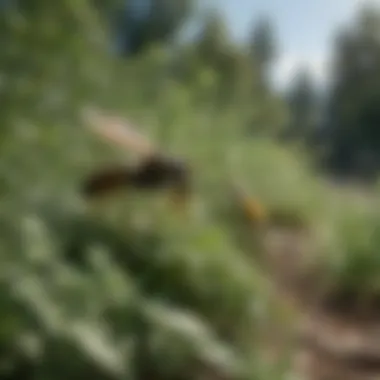Utilizing Flora for Effective Wasp Deterrence


Intro
This guide explores the intersection of flora and pest management, specifically focusing on how certain plants can effectively deter wasps. Understanding the role of these plants in natural pest control is becoming increasingly relevant. Eco-friendly practices are essential as homeowners and gardeners strive for sustainable methods to protect their outdoor spaces.
Understanding Pests
Definition of Pests
Pests are organisms that negatively impact human activities, plants, or livestock. They often compete for resources, transmit diseases, and generally cause economic harm. Wasps, in particular, can be troublesome during outdoor activities as they are attracted to various food sources. Identifying them correctly is important for choosing effective deterrence methods.
Importance of Pest Identification
Knowing different pest species, including wasps, helps in implementing appropriate control measures. Wasps belong to the family Vespidae and include various species, some of which are social and others solitary. Understanding this distinction can guide homeowners in selecting specific plants that repel these insects. Recognizing the signs of wasp presence aids in taking timely action to prevent infestations.
Prevention Techniques
Home and Garden Preventative Measures
- Plant Selection: Incorporate specific flora known for their repellent effects on wasps.
- Habitat Modification: Reducing spots around your home where wasps can build nests is essential.
- Waste Management: Secure garbage bins with tight lids to reduce attractants for wasps.
Seasonal Prevention Tips
- Spring: Monitor plants that attract wasps and consider removal or replacement.
- Summer: Maintain gardens by keeping food covered during outdoor events.
- Fall: As nests grow, check the yard regularly and take preventive steps before they become a problem.
Eco-Friendly Pest Control Solutions
Overview of Sustainable Practices
Sustainable pest management focuses on using natural resources wisely. By encouraging beneficial insects and using native plants, gardeners can develop ecosystems that naturally suppress pest populations, including wasps. Incorporating flora not only enhances aesthetic appeal but also promotes ecological balance.
Natural Remedies and Their Effectiveness
Some plants, like mint and citronella, are recognized for their repellent properties. Their essential oils can deter wasps effectively, making them excellent choices for gardens.
"Utilizing plants for pest management offers a dual benefit: enhancing beauty while controlling unwanted insects."
Engaging with these natural deterrents can empower homeowners to maintain pest-free environments without relying on chemical solutions. The strategies discussed serve to provide practical knowledge for sustainable gardening approaches.
Understanding the Wasp Behaviour
To effectively utilize plants for wasp deterrence, it is essential to understand the behaviour of wasps. Grasping how these insects operate can inform appropriate strategies for prevention. Wasps, particularly social species like yellow jackets and paper wasps, exhibit complex behaviors rooted in their colony structures, feeding preferences, and nesting habits. Different aspects of wasp behaviour can influence gardening practices, as well as decisions on plant species to incorporate into outdoor spaces. Understanding these factors can lead to more successful pest management solutions.
Colony Structure and Social Dynamics
Wasp colonies are organized and hierarchical. At the top is the queen, who is primarily responsible for reproduction. Worker wasps support the queen by foraging for food, building nests, and caring for larvae. Identifying these roles helps in understanding their foraging patterns and their attraction to certain food sources. For instance, worker wasps are scavengers and often seek sugars and proteins. Knowing this, homeowners can change their gardening habits, like avoiding sweet-smelling plants that might attract these insects during peak seasons.
Attraction to Food Sources
Wasps are particularly drawn to food sources. They seek out sugary substances, protein-rich options, and even decaying fruits. This attraction can be managed with strategic planting and maintenance in the garden. By opting for plants that produce less enticing scents or offer less nutritious food, one can potentially reduce the number of wasps in outdoor areas. Additionally, proper disposal of food waste and keeping outdoor spaces clean are crucial to minimize the food available for foraging wasps. A clean environment decreases the likelihood of these pests being attracted to backyard activities.
Nesting Preferences
Nesting preferences vary by species, with many predilecting to build their colonies in sheltered areas like under eaves, in tree cavities, or within dense shrubbery. Understanding these nesting habits can guide homeowners to modify their environments, making them less hospitable for wasps. Planting flora that offers inadequate cover or utilizing natural barriers can serve as effective deterrents. Additionally, more open areas with fewer nesting options deter the establishment of colonies. This knowledge can aid in creating a landscape that reduces the chance of wasp infestation, fostering a more pleasant outdoor experience.
Plants That Deter Wasps
The role of plants in repelling wasps is crucial for gardeners and homeowners seeking natural solutions to pest control. Utilizing specific flora can create a deterrent effect that reduces wasp activity, providing a more enjoyable outdoor space. These plants can serve multiple purposes, from enhancing the garden's visual appeal to offering practical benefits like pest management.
In this section, we will explore various plants known for their repellent properties, discussing specific herbs, essential oil-producing plants, and flowering species that discourage wasps. Understanding the characteristics and benefits of these plants can aid in making informed choices when designing a garden or outdoor area.
Herbs With Repellent Properties
Mint
Mint is widely recognized for its strong aroma, which acts as a natural repellent against wasps. Its high menthol content is especially effective in deterring these pests. Mint is a popular choice due to its versatility; it can be used in cooking or as a refreshing herbal tea.


One unique feature of mint is its ability to thrive in various conditions. It requires little maintenance, making it a practical addition to any garden. However, gardeners should be cautious as mint can spread quickly if not contained, which may lead to overcrowding other plants.
Basil
Basil is not just a culinary herb but also a beneficial plant for pest control. The strong scent of basil can repel wasps, making it an essential plant in the garden. Its competitive advantage lies in its culinary uses, which encourage more homeowners to grow it. Besides its deterrent properties, basil is attractive and adds beauty and flavor to dishes.
A consideration for basil is its sensitivity to cold temperatures. Basil is best grown in warm climates, where it flourishes. This can limit its use in areas with harsh winters, but it is an excellent choice for the right environment.
Thyme
Thyme, like mint, offers a distinctive aroma that helps to repel wasps. This herb is known for its resilience and can survive in poor soil conditions. Thyme is a beneficial choice because it can attract pollinators and beneficial insects while deterring pests.
One of thyme’s unique features is its drought resistance. Once established, it requires less frequent watering. However, thyme can be susceptible to certain pests, so it is good to monitor its health regularly in the garden.
Essential Oil Producing Plants
Citronella
Citronella is renowned for its strong scent, which is highly effective at repelling wasps. This plant is a popular pick among gardeners looking for natural deterrents. The key characteristic of citronella is its ability to produce essential oils that not only repel wasps but also ticks and mosquitoes.
One significant advantage of citronella is its use in homemade repellents. Gardeners can extract oils and use them as sprays. However, citronella can be challenging to grow in colder climates, which may limit its usefulness in some regions.
Geranium
Geranium carries a strong aroma that can deter wasps and other pests effectively. It's a beneficial plant not only for its beauty but also for its ability to improve pest resistance in gardens. Geraniums are hardy perennials, making them suitable for many different climates.
The unique aspect of geranium is its ability to bloom profusely, adding color to any garden. However, they can sometimes attract other pests, so it’s essential to keep an eye on their surroundings.
Lavender
Lavender is another plant that provides dual benefits of beauty and pest deterrence. Its fragrance is known to repel wasps while also being pleasant to humans. This makes lavender a popular choice for gardens where pest control is needed without sacrificing aesthetics.
Lavender is drought-resistant and thrives in well-drained soil, making it easy to care for. However, it prefers full sun and may struggle in overly shaded areas, so proper placement in the garden is vital for its growth.
Flowering Plants That Repel Wasps
Marigold
Marigold is a vibrant flowering plant that not only beautifies gardens but is known to ward off wasps. Its strong scent can repel various pests, making it a popular option among gardeners. Additionally, marigolds can attract beneficial insects such as ladybugs, which can help control other pests.
The unique feature of marigolds is their ability to thrive in poor soil and require little water. They can be a low-maintenance addition to any garden. Nevertheless, marigolds should be monitored for aphids, which can sometimes infest them.
Mint Plant
Having both culinary and pest-repelling qualities, the mint plant is a valuable addition to any garden. Much like regular mint, it produces a scent that may deter wasps. Mint plants are often considered beneficial because they offer herbs for cooking alongside pest control.
However, this plant can spread rapidly and take over garden space if not contained properly. Gardeners need to manage their growth effectively to maximize benefits without overcrowding.
Geranium
Once again, geranium finds a mention as it can also blossom as an attractive flowering plant. Its strong aroma is effective against wasps. Geraniums are recognized for their colorful flowers, enriching garden aesthetics.
While they serve multiple functions, geraniums can be prone to various pests such as spider mites. Regular care and monitoring are essential to ensure their health in the garden.
Overall, integrating these plants into a garden can create a more welcoming outdoor environment while keeping wasps at bay.
Various studies indicate that using plants for pest control can be highly effective and environmentally friendly, providing a sustainable alternative to chemical repellents.
Mechanisms of Plant Repellency
Understanding how and why certain plants repel wasps is crucial for effective pest management. This section delves into the chemical interactions and sensory responses that underlie this plant-wasp relationship. By grasping these mechanisms, homeowners can make informed decisions on incorporating specific flora into their gardens to naturally deter wasps.
Chemical Compounds Involved
Volatile Organic Compounds
Volatile organic compounds (VOCs) play a significant role in wasp deterrence. These compounds emit scents that can be pleasant or repugnant to human noses, but they are often neurotoxic or aversive to many insects, including wasps. A key characteristic of VOCs is their ability to disperse easily through the air, making them a beneficial and effective deterrent.


VOCs are often found in common plants like mint and basil. The unique feature of VOCs is that they act quickly; even a small amount can be enough to keep wasps at bay. A clear advantage of using VOCs is that they are natural and environmentally friendly, reducing reliance on chemical pesticides.
However, the primary disadvantage lies in their volatility. Their effectiveness may diminish with changing environmental conditions such as humidity and temperature.
Terpenes
Terpenes are another class of organic compounds with significant repellent properties. Found abundantly in essential oils, terpenes such as limonene and pinene contribute to the aromatic profiles of many plants. Their key characteristic is their strong scent, which, although appealing to humans, can deter insects.
In the context of this article, terpenes represent a valuable option for natural wasp control. They are particularly favored due to their potent olfactory impact on wasps, disrupting their ability to navigate and locate food sources.
One unique feature of terpenes is their multi-purpose nature, as they can also attract beneficial pollinators when used strategically in companion planting. The main disadvantage, however, is that some terpenes may have limited longevity in their repellent effect and may require reapplication after rain or watering.
Aliphatic Acids
Aliphatic acids, such as acetic acid, can be effective in repelling wasps as well. These acids are often found in certain fruits and can induce a deterrent response. A main characteristic of aliphatic acids is their sour aroma, which is generally unappealing to wasps.
In the realm of pest management, their usefulness stems from the fact they can disrupt wasp feeding habits. They provide homeowners with another natural option that complements the use of VOCs and terpenes. A notable advantage is their abundance in organic compost, promoting a holistic approach to garden care.
However, the downside is that while aliphatic acids can deter wasps, they may also affect other garden organisms, leading to unintended consequences for a balanced ecosystem.
Impact on Wasp Senses
Olfactory Responses
Olfactory responses are fundamental to how wasps interact with their environment. Wasps rely heavily on their sense of smell to locate food and identify potential threats. By using plants that emit strong scents, homeowners can effectively manipulate these responses. Plant species known for their aromatic properties can drown out the smell of food sources that attract wasps.
The key characteristic of olfactory responses is their sensitivity; even minute changes in chemical composition can have significant effects. In this article, understanding olfactory responses provides insight into how specific plant scents can deter wasps without risking harm to the integrated pest management system.
However, olfaction can also vary among different wasp species. This diversity means that a certain scent may work well for one species but not another. Targeting the right wasp population becomes essential in applying this knowledge effectively.
Tactile Reactions
Tactile reactions refer to the sensory feedback wasps receive when encountering certain surfaces or textures. Some plants exude sticky or spiny substances that can be physically unappealing to wasps. Utilizing this property can create an unfavorable environment for these insects.
The key characteristic of tactile reactions is their immediate impact; a wasp's encounter with a deterrent surface can lead to an instant retreat. This aspect is beneficial since it does not rely on the wasp's olfactory cue, offering an alternative pathway for deterrence.
Nevertheless, the challenges arise when considering the practicality of implementing such tactile barriers. Creating a garden environment that incorporates both appealing plants for humans while simultaneously deterring wasps can be complex. Thus, careful planning is necessary to maximize effectiveness.
Cultivation Strategies for Effective Deterrence
Cultivation strategies are vital for ensuring that the plants chosen for deterring wasps thrive. The success of these plants in repelling wasps is influenced by several key factors. Implementing proper cultivation strategies not only enhances plant health but also maximizes their repellent characteristics. Understanding site selection and soil preparation, as well as employing companion planting techniques, will significantly improve the effect of these plants in a garden or yard.
Site Selection and Soil Preparation
Selecting the correct site is crucial in the cultivation of plants aimed at wasp deterrence. Wasps are less likely to inhabit areas that are full of strong scents or have abundant vegetation that impairs their flight patterns. A location with partial sunlight can be beneficial, as many repellent plants require sufficient sunlight to grow robustly while being resilient to varying conditions.
The soil type also plays a significant role in supporting plant growth. Ensure that the soil is well-draining yet retains moisture. Heavy clay soils may need amendments such as sand or compost to improve texture and drainage. Soil pH can affect plant vitality; most herbaceous plants prefer slightly acidic to neutral soil (pH 6-7). Testing soil before planting can help identify necessary adjustments for optimal growth.
Additionally, consider surrounding factors such as proximity to food sources and nests, which may attract wasps. Creating barriers with repellent plants like basil or mint around outdoor dining spaces can provide an effective shield.
Companion Planting Techniques
Companion planting is an effective technique that combines different plant species for mutual benefit. This method enhances growth, deters pests, and can specifically assist in keeping wasps at bay. Certain herbs naturally repel wasps and can be used strategically alongside other plants.
For instance, planting mint near more fragrant herbs can maximize the overall repellent effect. Mint can also improve the health of neighboring plants. Likewise, marigolds can deter not only wasps but also other pests, benefiting nearby vegetables and flowers.
Furthermore, having a diverse plant palette is beneficial. An assortment of plants can confuse wasps and reduce their chances of locating specific food sources. Incorporating essential oil producing plants, like lavender, in combination with food crops not only dissuades wasps but also attracts beneficial insects that pollinate plants.
Utilizing these cultivation strategies will promote a healthier environment while effectively deterring wasps from outdoor spaces.
Challenges and Limitations
Understanding the challenges and limitations associated with using flora to deter wasps is crucial for anyone considering this approach. While plants can indeed be effective as a natural deterrent, several factors influence their overall efficacy. These factors range from environmental conditions to the specific ecosystem in which these plants are situated. Additionally, the potential for unintended consequences requires careful consideration.
Effectiveness Under Varying Conditions


The effectiveness of plants in repelling wasps can fluctuate depending on various external conditions. For instance, environmental factors like temperature, humidity, and rainfall can influence the plant's ability to produce volatile compounds that deter wasps. A dry season may impair essential oil production in some herbs, making them less effective when it comes to providing protection against invasive wasps.
Moreover, not all types of wasps respond similarly to plant traits. Different species may have varying levels of sensitivity to the same repellent compounds. Therefore, planting a single type of repellent plant does not guarantee success in deterring all wasp species. Homeowners need to consider a diverse selection of plants to enhance their chances of effective deterrence.
Potential Unintended Consequences
There is a subtle but significant risk of unintended consequences when using plants for wasp management. For example, while some plants may repel wasps, they could inadvertently attract other pests. Such unexpected visitors may disrupt the garden's ecosystem or create additional nuisances for homeowners.
Further complications can arise from the ecological balance within the garden. Introducing too many repellent plants may alter the existing habitats, potentially causing harm to beneficial insect species that support pollination and pest control. Therefore, it is vital to monitor the garden’s ecosystem closely and implement integrated pest management strategies that consider the relationship between various plants and insects.
A holistic approach is essential when utilizing flora for pest deterrence. Each plant and its inherent properties must be carefully evaluated to ensure they contribute positively to the overall garden environment.
In summary, while plants can serve as natural deterrents against wasps, understanding the challenges and limitations is essential. Variability in effectiveness under various conditions and the potential for unintended ecological consequences necessitate a thorough exploration of strategy and selection. This ensures a balanced and effective approach that maintains the health of the garden.
Alternative Wasp Control Methods
This section highlights the importance of exploring alternative wasp control methods that complement the use of plants for deterrence. Understanding these methods allows homeowners and gardeners to develop a more comprehensive pest management strategy. These methods can be pivotal in minimizing unwanted wasp encounters while ensuring environmental safety. Many people prefer non-toxic solutions, especially for families and pets. There is much to consider when selecting methods, including effectiveness, ease of use, and ecological impact.
Non-toxic Traps and Baits
Non-toxic traps and baits provide a practical solution to managing wasp populations without harming beneficial insects. These traps work by attracting wasps with a bait that is appealing, while still being harmless. Several types of materials and DIY recipes are available, making such traps an accessible option for everyone.
- Homemade Traps: A simple mix of sugar water or fruit juice in a bottle can attract wasps. Cutting the top off a plastic bottle and inverting it into the base makes an effective trap.
- Commercial Options: Brands like Rescue and Hot Shot offer traps designed specifically for wasps. They use a bait that lures wasps while preventing escape.
- Placement Considerations: To increase effectiveness, traps should be placed away from dining areas but close enough to wasp nesting spots. This helps in reducing the chances of wasps approaching home spaces.
- Monitoring: Regularly check and empty the traps to maintain their efficiency.
Mechanical Barriers and Exclusions
Mechanical barriers and exclusions focus on physically preventing wasps from entering specific areas. This approach is particularly valuable in domestic settings, such as patios and gardens, where people gather. Implementing these methods can greatly reduce the likelihood of a wasp encounter.
- Screens and Nets: Installing fine mesh screens on windows and outdoor spaces helps keep wasps outside. These screens are a simple solution that allows fresh air in while blocking pests.
- Sealing Entry Points: Regularly inspect and seal cracks and gaps around the home. This includes doors, windows, and siding. Proper sealing ensures that wasps have fewer opportunities to invade.
- Outdoor Dining: When eating outdoors, consider using tents or canopies with walls. This can provide a physical barrier that keeps wasps at bay.
- Timing: Wasps are more aggressive at certain times of the year, typically late summer and early autumn. Being cautious during these periods and applying exclusion methods can minimize encounters.
Overall, combining plant-based deterrents with non-toxic traps and mechanical barriers forms a robust pest management strategy. The balance between these approaches allows for a more peaceful and enjoyable outdoor environment.
Integrating Plants into Pest Management
The integration of plants into pest management, particularly for deterring wasps, is an essential aspect of sustainable gardening and pest control. This approach emphasizes the use of natural flora as a first line of defense rather than relying solely on chemical pesticides. Utilizing flora for pest deterrence not only mitigates wasp populations but also contributes positively to the ecosystem. An environment rich in diverse plant species can disrupt wasp behavior and nesting tendencies.
Holistic Approach to Pest Control
A holistic approach to pest control involves viewing the garden ecosystem as a whole rather than isolating individual problems. By integrating various plant species that repel wasps, gardeners can create an environment that is less attractive to these pests. This requires careful selection of plants based on their known repellent properties.
- Complementary Planting: Choose plants that not only deter wasps but also attract beneficial insects. For example, herbs like basil and mint can repel wasps while attracting pollinators. This practice enhances biodiversity.
- Soil Health: Healthy soil is fundamental for robust plant growth. Plants that thrive can better produce their natural repellents, which in turn increases their effectiveness against wasps.
- Seasonal Considerations: Different plants perform better in certain seasons. A strategic selection allows for ongoing wasp deterrence throughout the growing season.
By intertwining the concepts of biodiversity and natural repellents, a garden can become resistant to wasps organically.
Evaluating Long-term Effectiveness
Evaluating the long-term effectiveness of plant-based wasp deterrent strategies involves consistent monitoring and adaptation. Homeowners must track changes in wasp behavior and garden dynamics over time.
- Observation: Regularly observe the presence of wasps and any changes in their behavior as new plants are integrated. Note which plants are highly effective and adjust the garden layout accordingly.
- Plant Longevity: Assess the health and lifespan of the repellent plants. Some plants may require more maintenance than others, impacting their effectiveness over time.
- Environmental Changes: Be aware of external factors such as climate changes and their influence on plant growth and insect behavior. Prepare to alter planting strategies based on these observations.
In summary, integrating plants into pest management requires a thoughtful and dynamic approach. By understanding the interconnectedness of plants, pests, and the environment, one can cultivate a garden that is both beautiful and effectively resistant to wasps.
Finale and Recommendations
Utilizing plants for wasp deterrence offers a sustainable approach to managing these pests in both gardens and outdoor spaces. This article underscores the significance of integrating flora into pest management strategies. Adopting these eco-friendly methods not only minimizes reliance on chemical pesticides but also promotes biodiversity within the ecosystem.
The key benefits of using plants for deterring wasps are multifaceted. Firstly, plants such as mint and lavender contain natural compounds that exhibit repellent properties. Secondly, such a greener approach enhances the overall aesthetic and functionality of outdoor environments without causing harm to beneficial insects.
Homeowners should consider several factors when implementing plant-based deterrents. Site selection, plant compatibility, and maintenance are crucial aspects. It’s vital to ensure that the selected flora will thrive in the local climate while interacting positively with existing plants. Moreover, regular care is needed to preserve their effectiveness.
In summary, integrating flora into pest management can yield notable advantages, both environmentally and practically. Through this holistic approach, homeowners can create more pleasant spaces free from the nuisance of wasps.
Key Takeaways
- Plant-based deterrents reduce the need for chemical pesticides.
- Specific plants like basil and geranium can effectively repel wasps.
- Regular maintenance and appropriate site selection are critical for success.
- This method not only protects gardens but also enhances biodiversity.
Future Research Directions
Further research is needed to fully understand the complex interactions between plants and wasps. Key areas for exploration could include:
- The long-term effectiveness of specific plant species in various climates.
- The potential impact of companion planting on pest management.
- The allure of wasps to certain plants and how it can be mitigated.
Additional studies could help to refine cultivation practices and improve strategies for deterring wasps, thereby providing more comprehensive guidelines for homeowners seeking to maintain a pest-free garden. Engaging with current literature and communities can foster knowledge sharing and spur innovation in eco-friendly pest management.



